Question
jurisdiction England and Wales, references from case law and statutory provisions 1. Understand historical events leading to the development of Equity - Key historical events
jurisdiction England and Wales, references from case law and statutory provisions
1. Understand historical events leading to the development of Equity
- Key historical events that led to the creation of equity and common law
- The significance of Earl of Oxford's case
- The distinction between common law, equity and statutory rules
- The administrative fusion of equity and common law (The Judicature Acts)
- Equitable maxims: twelve maxims (general principles or rules); their meaning, use
and misuse; discretionary nature of maxims
2. Understand the requirements for the creation of a valid private express trust
- Types of trusts and powers - fixed v discretionary trust, bare powers, fiduciary powers, trust powers
- Three certainties - certainty of intention (words (precatory v mandatory), conduct, implications); certainty of object - given postulant v complete list test, various interpretation of the given postulant test, conceptual uncertainty, evidential uncertainty, ascertain ability of beneficiaries, administrative unworkability, methods of curing uncertainty; certainty of subject - distinction between tangible and intangible properties, uncertainties, methods of curing; consequences of lack of any of the certainties
- Formalities - s.53(1)b and s.53(1)c of the LPA; distinction between declaration and disposition
- Constitution - the principle of Milroy v Lord, the application of maxims "equity will not assist a volunteer" and "equity will not perfect an imperfect gift", exceptions - Re Rose, Choithram v Pagarani, Pennington v Waine; donatio mortis causa, Strong v Birds, proprietary estoppel, Contract (Rights of Third Parties) Act 1999, trust of promise, fortuitous vesting.
- Impact of illegality on legal presumptions: circumstances in which resulting trust arises; Patel v Mirza (2016): Lohia v Lohia 2001.
Features of different types of trust Equitable principles that govern the creation, validity and failure of public trusts (charities)
- Meaning and interpretation of charitable purpose (Pemsel's categorisation, new heads under Charities Act 2006, Charities Act 2011)
- Meaning and application of public benefit including discussion regarding the Charity Commission's role and its guidance on public benefit
- Meaning and application of the clause 'wholly and exclusive charitable' The doctrine of cy-pres (initial failure and subsequent failure).
The concept and application of constructive trust
- Nature of constructive trusts - remedial v institutional constructive trusts, consequences of classification
- Fiduciary duties - non-conflict and non-profit rules, duty to act without remuneration and exceptions, self-dealing, fair- dealing, corporate opportunity doctrine, equitable principles dealing in the context of bribery, defences to breach of fiduciary duties, equitable remedies for breach of fiduciary duties, distinction between personal and proprietary liability
- Third parties' liabilities - dishonest assistance (conditions for liability, meaning of assistance, meaning of dishonesty (objective, subjective, combined objective & subjective tests, semantic v substantive differences, remedies; receipt based liability (conditions for liability, requirement of mental state, different types of knowledge, meaning of unconscionability in this context, distinction between knowledge and unconscionability, meaning of beneficialreceipt; remedies
- Differences between strict and fault-based liabilities.
The concept of resulting trusts
- Circumstances in which resulting trusts apply - failure of trust, presumed intention of the parties, failure to dispose of full beneficial interest, dissolution of unincorporated association Presumption of resulting trust
Presumption of advancement in the context of Equalities Act 2010
- Theories that aim to explain the reasons for why resulting trusts exist as opposed to
when it will arise - presumed intention, automatic resulting trust, prosulting trust, lack
of intention to benefit third party, Swadling, Penner, Millett and Birk's theories
- The concept of unjust enrichment
- The principles of Qustclose trust and theories explain its compatibility (or lack of it)
with orthodox equitable rules.
3. Understand the concept and application of the beneficiary principle and exceptions
- The need for a human beneficiary - The rule in Saunders v Vautier - Trusts of imperfect obligations / purpose trust - recognised purposes (animals, monuments / tombs, fox hunting, private masses), perpetuity rule, need for a willing trustee - Judicial constructions - Re Denley's, Re Osoba / Re Bowes - Gifts to unincorporated associations - various theories how such gifts can be upheld including contractual theory.
4. Understand equitable remedies
- Distinction between tracing and following - Common law tracing - conditions for application, issues with mixture of properties, change of position defence Equitable tracing - conditions for application (fiduciary duties, beneficial interest, property in traceable form, no inequitable result), various methods of attribution (first in - first out, beneficiary election approach, swollen asset theory, pro-rata principle), meaning of dissipation, principles of subrogation, principles of backwards tracing; defences; change of position (restitution and unjust enrichment). - Specific performance - conditions that must be met before such remedy can be granted, nature of remedy - Injunctions - conditions that must be met before injunctions can be issued, reasons for its existence, nature of remedy In tracing, students must be able to demonstrate the ability to distinguish scenarios where facts can produce definitive outcome and when facts are insufficient. In the latter case, students need to know when they are permitted to speculate and when they just need to look at alternative angles.
5. Understand trustees' administrative powers and duties
- This learning outcome relates to administrative duties that are distinct from fiduciary duties. - Power of advancement - conditions and rules governing application - Power of maintenance - conditions and rules governing application
- Duty of care - meaning and application - Duty to invest - Trustees Act 2000, principles of rational investments, defense - Limitation of liability - validity, application, effects.
Step by Step Solution
There are 3 Steps involved in it
Step: 1

Get Instant Access to Expert-Tailored Solutions
See step-by-step solutions with expert insights and AI powered tools for academic success
Step: 2

Step: 3

Ace Your Homework with AI
Get the answers you need in no time with our AI-driven, step-by-step assistance
Get Started


